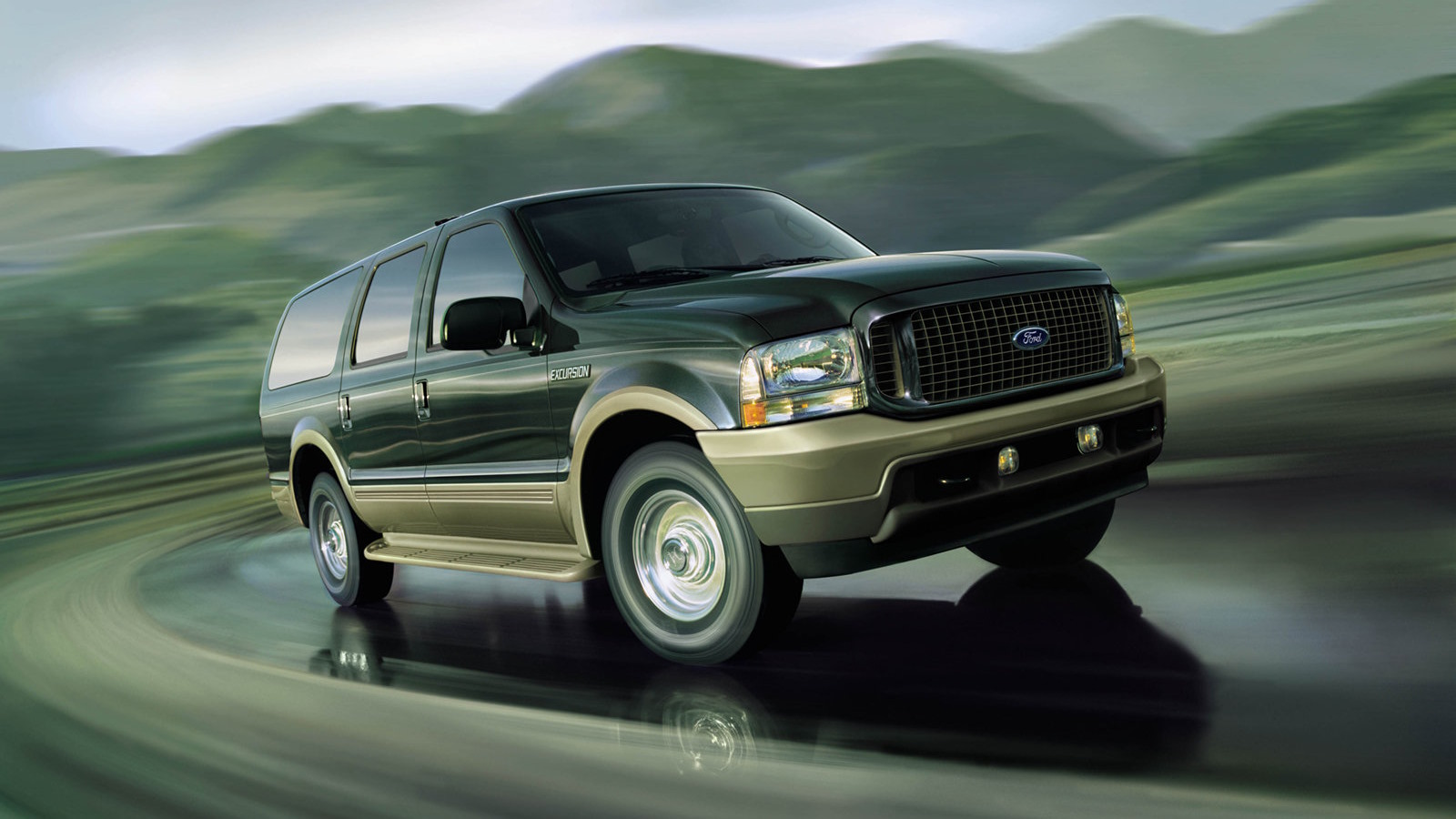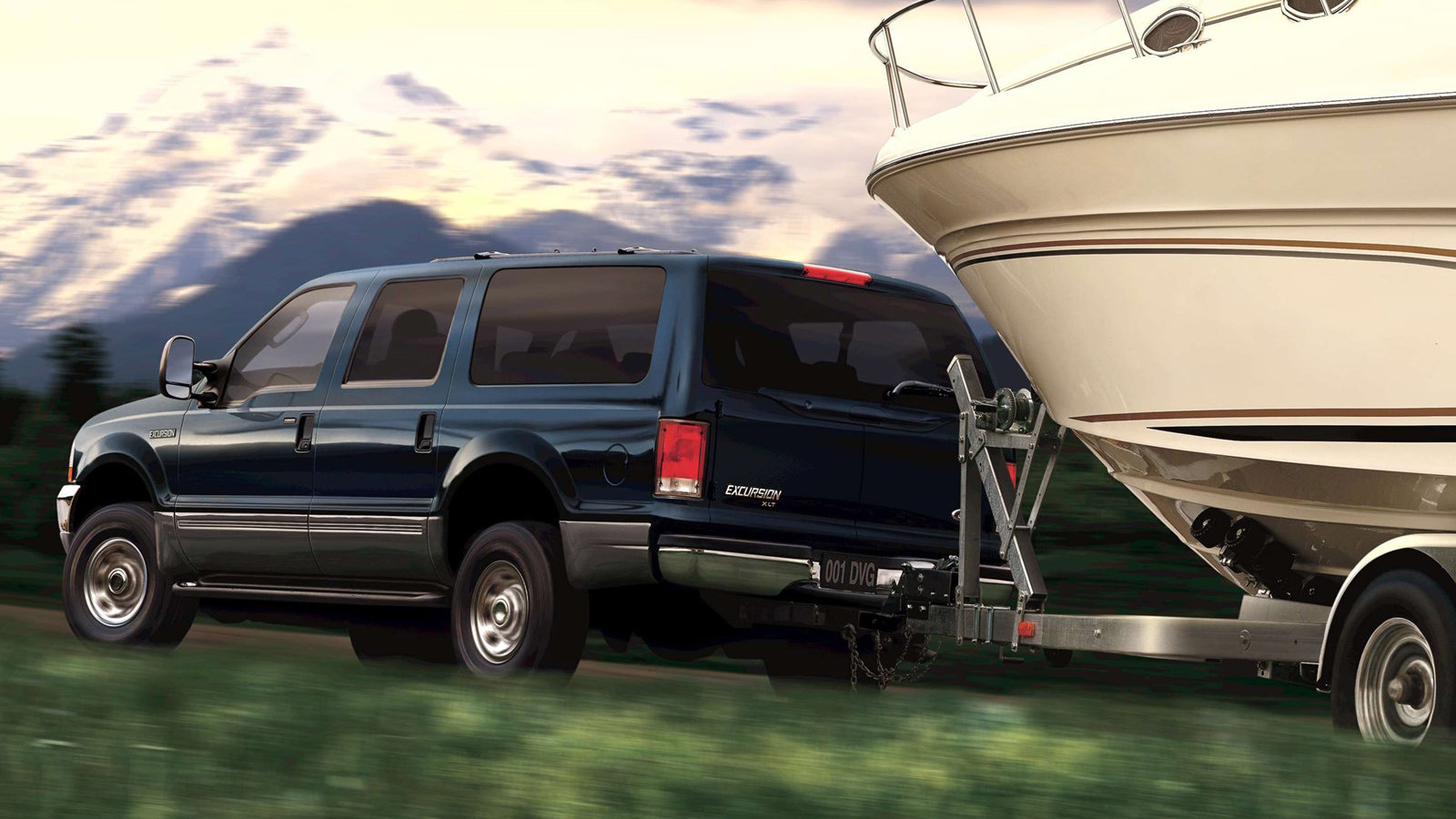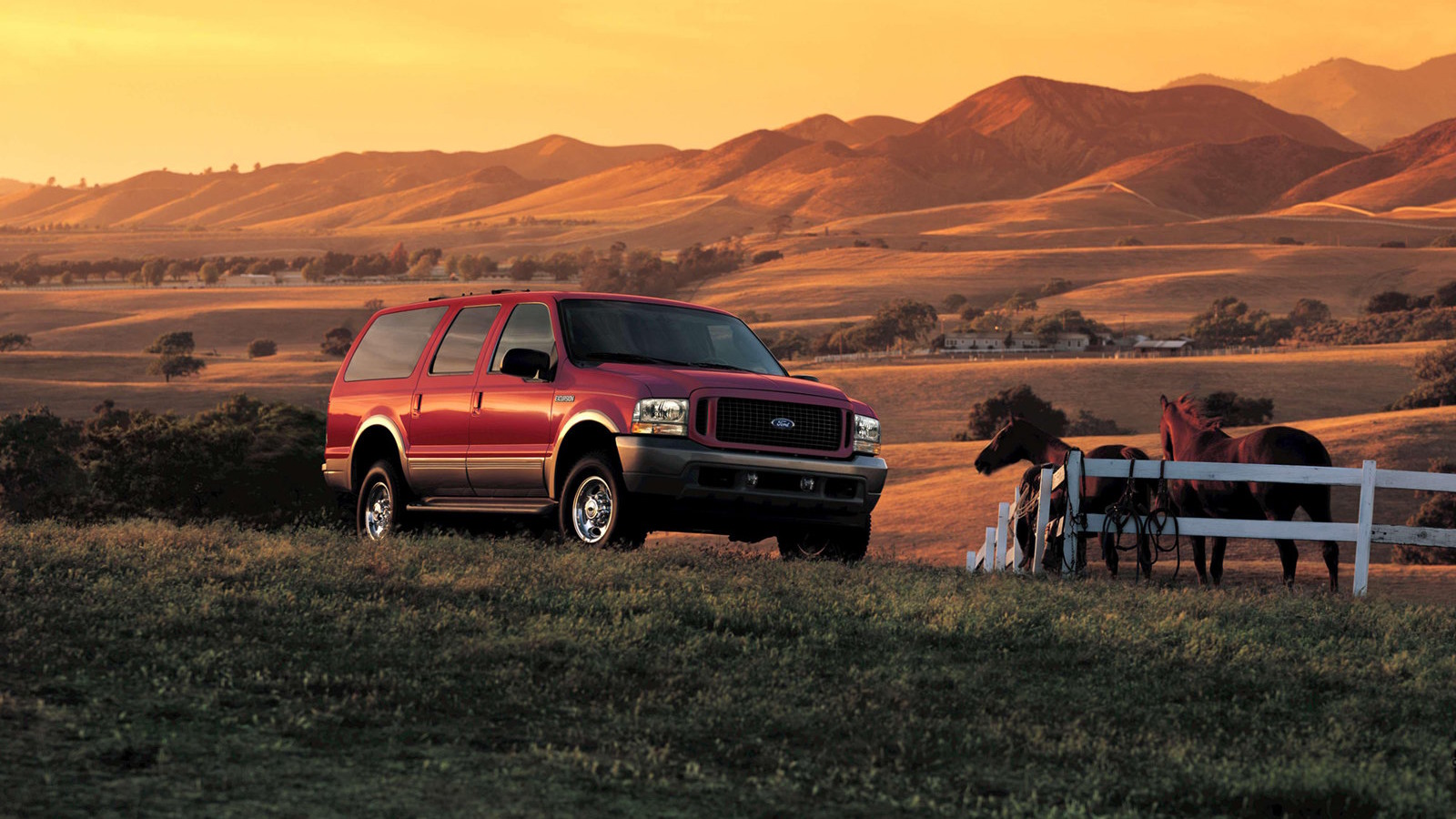
[ad_1]
If the 1980s marked the rise of the minivan, the 1990s marked the rise of the SUV. Truck-based, beefy, and thoroughly divorced in capabilities and demeanor from modern crossovers, SUVs were marketed as go-anywhere, do-anything transportation for the entire family. As with any emerging segment, there’s always one automaker that pushes the boundaries of what’s possible. Before the Hummer H2 was even a twinkle in GM’s eye, another SUV had launched with gargantuan proportions. It could tow up to 11,000 pounds, had an enormous cabin, was protested against in multiple countries, and continues to be worth impressive money on the second-hand market, defying expectations of depreciation. We’re talking about a real-life Canyonero. Here’s why the Ford Excursion is still so highly desired.
Bigger, Badder, Bolder

The Ford Excursion is a figurehead for the truck-based SUV age, but the blue oval wasn’t the first to offer a three-quarter-ton SUV. Not even close. Chevrolet had already been making three-quarter-ton Suburbans for decades before Ford introduced the Excursion in 1999, and they were fairly successful. However, Ford dialed M for Marketing when it unveiled the Excursion as a separate production line from their Suburban-rivaling Expedition, suddenly thrusting truly massive SUVs into the spotlight. At the time, it made perfect sense for the Excursion to be a separate product line from the Expedition because Ford split off its heavy-duty pickup trucks under the Super Duty sub-brand for 1999. This new truck received radically different styling from the light-duty F-150 pickup truck to go with increased capability, and it was a no-brainer to use Super Duty components to save costs on the Excursion.

So how do you turn a Super Duty into an SUV? You start with a brand new frame. Yes, some architectural components of the Super Duty fit on the Excursion, which is why the two vehicles share track widths, but the Excursion gets its own unique ladder frame. Next, you take that frame and sling it under an SUV-style cab featuring a wicked set of Dutch doors. Around the back of the Excursion, the rear window lifted up and the two halves of the tailgate swung out for the best of both worlds. It was an idea shamelessly swiped from the Chevrolet Astro minivan, but it had great benefits to Excursion buyers — a half-sized liftgate was easy to open with a massive trailer hitched up. Through those nifty cargo doors, you’d find tons of room for both stuff and people. The Excursion could seat up to nine in complete comfort, with 39 inches of third-row legroom. That’s more legroom than in the backseat of a new Toyota Camry in the third row of the Excursion.
Commodious room and nifty cargo doors are great, but Ford had bigger fish to fry, specifically not being an absolute menace in collisions. It doesn’t take a rocket scientist to realize that heavy duty pickup truck bumpers are higher than the bumpers on most sedans, and this height mismatch could have deadly consequences. Ford figured the best way to avoid these issues was to extend crash elements downwards, with a special trailer hitch out back and something called the BlockerBeam up front. Sitting several inches below the Excursion’s enormous frame horns, the BlockerBeam was a deformable crash element meant to fix bumper disparity. It was a novel solution, and an effective one at that. Left Lane News reported that in 2003, several automakers pledged to align SUV and truck crash beams with those of passenger cars by 2009. The Excursion was ahead by a decade.
[Editor’s Note: The Jeep Wrangler JK also included such a low-hanging beam, though it was called a “Compatibility Beam.” I think the JL’s front one is actually a bolt-on, where as the JK’s was integral. -DT].

With crash safety, bodywork, and interior room taken care of, Ford turned its attention to sorting the way the Excursion went down the road. Unsurprisingly, heavy duty pickup trucks historically aren’t known for ride quality. When someone complains of a truck-like ride, they aren’t talking about butter-smooth Ram 1500s, they’re talking about old work trucks. On the face of things, the Excursion was almost as ancient as trucks came. Two-wheel-drive models sported twin I-beam front suspension that first appeared in 1965. The 4×4 model? That thing came with a solid front axle, a bit like a Jeep Wrangler or a horse carriage. Still, the science of these suspension systems was largely worked out by 1999, so Ford set to work making the Excursion comfier than its open-backed sibling. We’re talking new springs, dampers, bushings, and anti-roll bars. In short, the works. The crazy part? It all worked. Period reviews were overall positive. Let’s take a look at what Car And Driver had to say in 1999 about the Excursion’s ride and handling:
As impressive as it is in shouldering aside mass quantities of air, what’s even more impressive is the Excursion’s deportment at all speeds, great and small. The steering, although limited in feel, is surprisingly quick and accurate, lending an eager feel to turn-in, and a relatively high level of roll stiffness keeps cornering attitudes gratifyingly flat. There’s a trade-off in ride quality–the Excursion is distinctly firmer than the current Suburbans–but initial compliance takes the hard edge off sharp humps, and in any case we prefer the stronger sense of control that goes with the Ford setup.
See? It’s not a weapon to surpass Metal Gear when the roads get curvy, but it’s not a complete shed either. Not bad for 226.7 inches of SUV. Oh, and that was just the start for the Excursion. For 2001, horsepower out of the diesel motor got a slight boost, fog lights became standard on Limited models, mirrors gained those nifty indicators you seemingly only saw in the aughts, and a VHS player became a late-availability option.
For 2002, the trailer hitch receiver mounting bolts were beefed up to increase maximum towing capacity, power-adjustable pedals came online, buyers who wanted to keep their kids occupied could spec a wicked rear-seat entertainment system with a DVD player, and two new trims became available. The XLT Premium trim added alloy wheels, power front captain’s chairs, automatic headlights, rear seat audio controls, illuminated running boards, powered vent windows, a trip computer, and a stripe to the base model. The Limited Premium trim took the previous top-dog model and gave it a leather-wrapped steering wheel with climate and audio controls, heated front memory seats, Homelink, and power-adjustable pedals. Not bad, right?

The 2003 model year brought a new diesel engine as a mid-year option, and marked the introduction of the Eddie Bauer trim to the Excursion lineup which effectively replaced the non-premium Limited trim with a flourish of champagne paint. 2003 also brought minor quality-of-life improvements, like an entry grab handle for the driver and a reversible cargo mat on Limited models. For 2004, trim levels got re-jigged again, with the XLT Premium simply becoming the XLT, and the XLT becoming the XLS. That may sound confusing, but it actually made things a whole lot simpler in showrooms.
The final 2005 model year brought larger cosmetic changes, giving the Excursion Ford’s then-new tri-bar corporate grille. Flanked by new headlamps, it brought the Excursion’s styling into the mid-aughts, although some prefer the purity of earlier models. The base XLS trim also gained 16-inch aluminum wheels, a nice way of jazzing up the entry-level model’s appearance.
Getting Oily

Over its seven model year lifespan, the Ford Excursion was offered with four different engines, all of which are varying degrees of good. At the bottom of the heap sat the six-liter Powerstroke diesel V8 that was absolutely terrible. Fundamentally, it’s a Navistar VT365, a flawed engine that’s expensive to put right. Bulletproof Diesel built a solid name fixing issues with these 6.0-liter diesel engines, and its list of common documented problems is impressive. The oil coolers fail, the EGR coolers get plugged up with carbon, the 48-volt fuel injection control module wears out over time, head studs pull out of the block, and the factory water pump’s plastic impeller cracks. Granted, these aren’t insurmountable issues. In Bulletproof Diesel’s words, “Sure enough, there was a way to make these engines reliable and durable without sacrificing power.” However, it can be quite costly to fix the 6.0’s factory flaws.
Next up the chain is the gasoline-powered 5.4-liter two-valve Modular V8, which is the definition of an engine. Alright, so maybe the spark plugs didn’t always like their homes and maybe 255 horsepower and 350 lb.-ft. of torque just weren’t enough for a vehicle this big, but the 5.4 would live life in the right lane for pretty much as long as you like. There’s nothing here that’s outstanding, which is why the 5.4 isn’t particularly desirable. Speaking of gasoline-powered engines, the 6.8-liter Triton V10 was a marked step up in performance from the 5.4-liter mod motor. Sure, early examples could still eject spark plugs and fuel economy wasn’t brilliant, but 310 horsepower and 425 lb.-ft. of torque isn’t bad any way you slice it.
The indisputable holy grail of Excursion engines is the 7.3-liter Powerstroke diesel V8, a Navistar T444E that’s tough as nails. It’s not nearly as costly to keep a 7.3-liter Powerstroke on the road compared to a 6.0, and fuel economy is markedly better than on gasoline-powered models. Now, since the Excursion isn’t a light-duty vehicle, we don’t have EPA stickers to go by. However, Fuelly is an app that lets drivers track their fuel consumption, so it’s a large bank of data on real-world vehicle mileage. Based on data submitted by Fuelly users, the 7.3-liter Powerstroke Excursion averages 13.76 mpg. That’s not great, but the 6.8-liter gasoline-powered V10 is averaging 9.67 mpg, while the 5.4-liter V8 is averaging 10.55 mpg. Who wouldn’t kill for about a 30 percent improvement in fuel economy?
Oh So Controversial

Despite being an absolute beast for towing huge things with the family, not everyone liked the Ford Excursion. Like the Hummer H2 and Eminem, Ford’s biggest SUV became something to demonstrate against. In 2004, the Orlando Sentinel wrote:
A group of environmental activists has initiated “Jumpstart Ford,” a series of protests at Ford dealers in the United States and Canada to force what it calls “the EPA’s worst-ranked automaker to stop driving America’s oil addiction,” according to the Chicago Tribune.
The group said it will use “creative interventions ranging from street theater to one-on-one meetings with dealers” to deliver its message. And the message is that “Ford’s addiction to oil is a crime against humanity” and that Ford is “responsible for global warming” not to mention “dangers to public health, national security, economic stability and human rights.”
Yeah, the 2000s wasn’t the most rational decade in history. It turns out, oil-related concerns about national security were largely hyperbolic, high-margin vehicles help automakers achieve economic stability, giant SUVs aren’t even close to reaching the pantheon of high crimes against the environment, and human rights? It’s a noble cause, but the human rights effects of SUVs are low down the list of priorities.”

Needless to say, the protests didn’t amount to a whole lot, even in the short term. The Chicago Tribune reported that Jumpstart Ford tried claiming victory when dealership group AutoNation co-signed a plug-in hybrid initiative in 2006. However, the initiative didn’t have anything to do with the protests.
Rather, the protests were Jumpstart’s way to pressure the auto chain to refuse to buy any vehicles from Ford unless it stops building big SUVs, pickups or any other machine Jumpstart feels consumes too much petroleum. It is Jumpstart Ford, after all.
To that demand, AutoNation told Jumpstart to go jump or something to that effect.
You can’t argue with crazy. These days, while Ford builds a mix of battery electric vehicles, plug-in hybrids, traditional series-parallel hybrids, and good ol’ fuel-burners, it’s selling fewer cars than ever. Just about the only thing it sells in America that isn’t an SUV, crossover, truck, or van is the Mustang. America’s favorite vehicle is still the Ford F-Series pickup truck, and the general sedan market is smaller than anyone would’ve imagined in the mid-aughts. However, the Excursion was discontinued at the end of 2005, replacing it with a long-wheelbase Expedition that held greater mass appeal. Oh, the power of the almighty dollar.
Time Heals All Wounds

Looking back from where we are now, all the backlash and hysteria over three-quarter-ton SUVs seems ridiculous. The Jeep Wagoneer L measures identically to the Excursion from stem to stern, is 3.6 inches wider and eight-tenths of an inch taller than an Excursion, and elicits little more derision than the occasional eye-roll. The current Chevrolet Suburban is almost Excursion big, yet it isn’t viewed as completely preposterous either. Even crazier? It’s not like these new vehicles are objectively more capable than the Excursion. Despite more power and bigger brakes, the Jeep Wagoneer L falls 1,000 pounds short of matching the 7.3-liter 4×4 Excursion’s maximum towing capacity of 11,000 pounds, and the Chevrolet Suburban doesn’t come close. Oh, and the GMT800 three-quarter-ton Suburban eclipsed even the Excursion with a maximum towing capacity of 12,000 pounds.
These days, nice Ford Excursions trade for impressive money, depending on engine. Gasoline-powered examples are still semi-affordable, such as this two-owner V10-powered Excursion selling for $16,016 on Cars & Bids back in 2021. Models with the questionable six-liter Powerstroke engine aren’t at the top of the value heap, but nice ones are still expensive. This one-owner Excursion with 74,000 miles sold for $27,400 on Bring A Trailer. As for nice examples with the 7.3-liter Powerstroke V8, this one-owner example with 64,000 miles sold on Bring A Trailer in August for $46,000. There’s still huge demand for these Excursions, partly because they never got a successor and partly because they’re still great at towing. Of course, it also helps that Ford sold enough Excursions for them to not be excessively rare, but few enough that good ones are getting thin on the ground. Sales data claims 195,405 were sold in America between 1999 and 2005, fewer than the number of Explorers Ford sold in 2022 alone.
The Future Is Big

Could three-quarter-ton SUVs be poised for a comeback? Possibly. With states like California pushing for all-EV deadlines on new cars and light trucks, one potential solution for drivers whose needs just aren’t compatible with EVs is a segment of vehicles too heavy to be light-duty. We already have plenty of heavy duty pickup trucks gallivanting about, what difference does it make if some of them don’t have beds? Of course, some people would buy three-quarter-ton SUVs for the culture war, but others would often tow big trailers with them, a current sore spot for EVs.

Of course, you don’t have to wait for Ford to build another Excursion. Wilmington, N.C.-based MegaRexx will sell you something called the SVN, a three-row SUV based on heavy duty bones. Bring them a brand new Ford Super Duty and for as little as $40,000, they’ll convert it into an SUV with entirely aluminum bodywork and add a third row of seats. There is a fairly visible additional roll bar for third-row roof stiffness and seatbelt mounting, and the coachwork is a matter of taste, but this is one option for a seriously big SUV. If that doesn’t appeal to you, might I suggest a restomod of sorts? There’s a whole market out there for worked-over Broncos and Land Cruisers, and the Excursion will undoubtedly fall into the same camp of classic SUV someday. Now, I’m not expecting Jonathan Ward to go to town making an ICON Excursion, but I wouldn’t be surprised if someone starts taking in rusty old examples of these rigs and giving them new leases on life.
With much of the vitriol of the aughts faded, the Ford Excursion can now be seen for what it is — a damn fine machine for a specific type of work. People who love them these days often have owned more than one. It’s a big, friendly giant that’s not as ginormous as it used to be, an unintended side effect of a bigger world. Literally and figuratively, the Ford Excursion is the next big thing in collectable SUVs. If you need to tow long distances with an entire crew onboard, buy one while prices are still reasonable.
(Photo credits: Ford, MegaRexx Trucks)
Support our mission of championing car culture by becoming an Official Autopian Member.

Got a hot tip? Send it to us here. Or check out the stories on our homepage.
[ad_2]